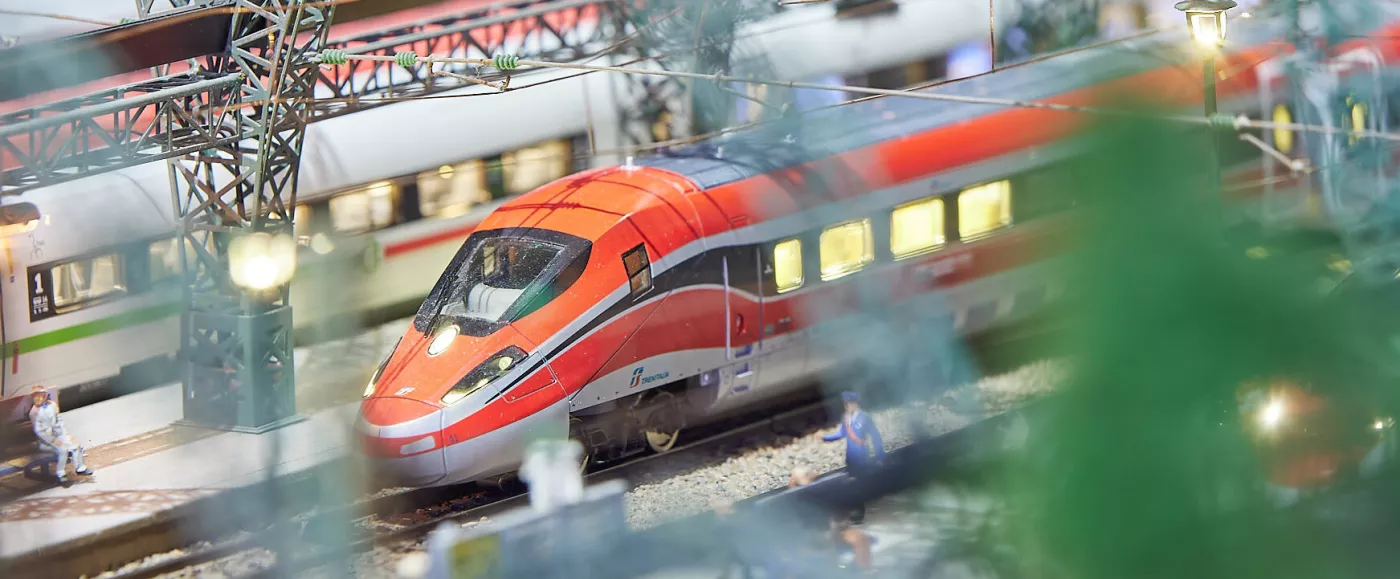Conquering the Air: The Challenge of Aerodynamic Trains
Smooth surfaces, soft edges, wing profiles. When it comes to aerodynamic trains, it's all about study and detail, but also about vision. The ability to see beyond is essential to face an invisible challenge: that of air. If speed is the goal to achieve, air resistance is the most cumbersome obstacle that every locomotive must overcome – an unavoidable hurdle.
Fluid dynamics (a scientific discipline that gained strong academic momentum in the late 19th century, coinciding with the birth of the first locomotives, with the introduction of the concept of theoretical aerodynamics based on the studies of the Austrian physicist Ernst Mach) sets in motion the crucial variables for any purpose of movement: pressure, density, temperature, the relationships between space and time – ultimately, all the ingredients of speed.
That's why mechanical engineers have pursued aerodynamics since the beginning of the 20th century, considering it an indispensable quality for the technical development of the entire railway industry.
The Schienenzeppelin train: The airship on rails
The train that became the innovation protagonist of the 1920s originated from a simple yet visionary idea: 'Why push a locomotive with wheels when you can use an airplane propeller?'
And so, the Schienenzeppelin triumphs in its challenge with the air. The prototype is the creation of German engineer Franz Kruckenberg and puts into practice the most modern construction techniques, along with extensive use of aluminum. In 1930, the locomotive emerged from the Hannover-Leinhausen workshops.
It's a train like never seen before. In an era still dominated by steam, bulky and opaque locomotives, the 'Zeppelin on rails' – with its elongated shapes and glossy surface – must have seemed like a silver bullet from a science fiction film.
It consists of a single cabin capable of accommodating 40 passengers, furnished in pure Bauhaus style, set to become an icon of the emerging modernity. The propulsion is entrusted to a 600-horsepower BMW aircraft engine that drives the centerpiece: a massive ash wood propeller.
Its performance is extraordinary. On June 21, 1931, on the Berlin-Hamburg line, it set a world record: 230 km/h. A milestone unbeaten until 1954.
A speed that impressed the entire world, at the expense of its longevity. After the initial enthusiasm, the Rail Zeppelin, in fact, cooled down quickly: using propeller propulsion in crowded stations was too risky, and the shape of the locomotive made it difficult to add more cars. After a few years of inactivity, in 1939, the Rail Zeppelin was dismantled: for Nazi Germany, all that aluminum was too precious a resource for the war industry.
Inside the HZERO model railway layout in Florence, visitors can catch sight of the Schienenzeppelin model, celebrating the innovation and vision of this futuristic locomotive. It allows the enthusiasts and admirers of engineering design to appreciate up close the charm and audacity of the 'Zeppelin on rails.' With its elegant shape and extraordinary technical features, this model remains an indelible icon in the history of rail transport.
The legacy of the Schienenzeppelin and the Pendolino trains
After the experience of the Schienenzeppelin train, the baton of aerodynamic evolution in the railway industry was passed to a new protagonist.
In the mid-1960s, engineers were in search of a practical solution to enhance the railway network, especially in Italy. This is particularly important to keep up with the development of road motorization, where highways were seen as a promising new horizon. To compete effectively, a train is needed that can travel faster on traditional lines without altering the existing railway infrastructure.
Attention turns to the concept of "tilting": the ability of the carriage to lean into curves, reducing lateral resistance and improving stability. Thus, a new generation of trains is born, indeed, a true icon for all railway enthusiasts.
The Pendolino dominated the railway scene in the 1960s and 1970s, thanks to its reliability. The ability to tilt not only enhances passenger safety and comfort but also reduces aerodynamic resistance, allowing the train to maintain higher speeds even on curves – this is how the Pendolino conquers its challenge against the air.
The significance of this locomotive is not only derived from its performance; on the contrary, it has become almost an anthropological means, transporting the country towards a modern conception of connections and distances. It has also been described as "the train that shortened Italy": Milan-Rome became a daily route, various regional capitals were connected with each other and with the Italian Capital city. Thanks to the Pendolino, Italy found a new everyday travel routine.
High-Speed and Beyond: The New Horizons of Aerodynamic Trains
Today, the design of aerodynamic trains is entering a new era. Technology has inspired subsequent prototypes and reaffirmed the importance of research in the railway sector, ultimately opening the doors to a new chapter in rail travel: high-speed trains.
New technologies – such as advanced computer-aided modeling and airflow simulation – allow engineers to further refine the shape of trains to reduce aerodynamic resistance. Additionally, advanced propulsion systems, such as high-power electric motors, contribute to increasing energy efficiency and reducing environmental impact. Here lies the new true contemporary challenge, where air becomes the atmosphere, no longer to be conquered but to be protected.
Among the expressions of this new design concept, bright examples stand out, such as the Japanese Shinkansen. A combination of extraordinary performance, cutting-edge design, and a light environmental footprint, thanks to the most advanced technologies. These trains not only offer exceptional speed but also superior comfort and safety, making them inspirational models for future projects.
In conclusion, the challenge of air has driven ingenuity and railway innovation from the beginning and continues to represent flourishing opportunities for development. On the horizon, locomotives are racing faster, more efficient, and environmentally friendly. Aerodynamic trains are a continuously evolving sector, destined to shape the future of rail mobility.


